Dee Estuary Birding
Monthly Newsletter...
July 2024
Newsletter
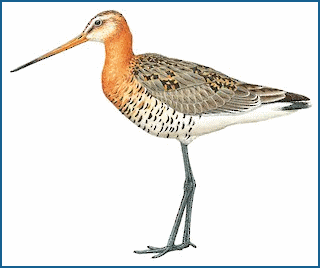
Grey Plumage Red Knots in June at Leasowe!
You would be
forgiven to think that until recently it was still winter with the
cold, windy and rainy weather we had, and the presence of several
thousand Red Knot, mainly in grey plumage, feeding off the shore at
Leasowe.
Ö..but hold on a minute, this is June! What is going on?
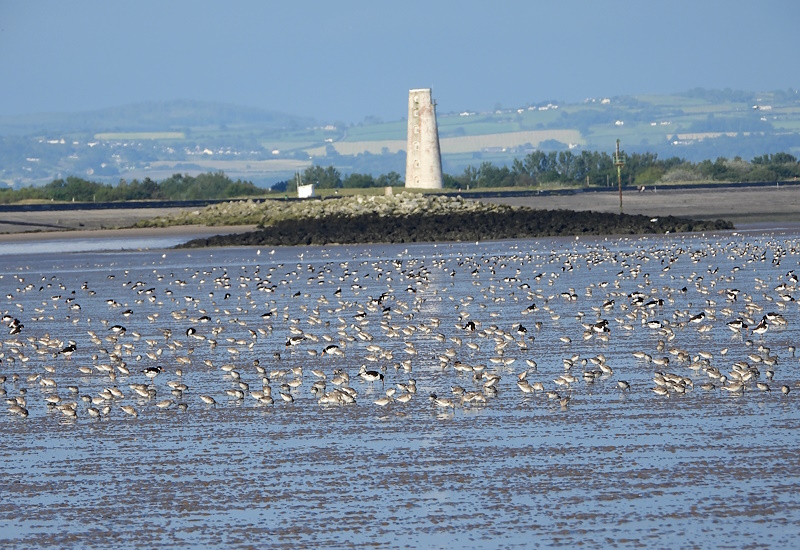
Red Knot (Calidris canutus islandica) are a very common winter sight along the Wirral shoreline at many sites (Thurstaston, West Kirby, Hilbre, Hoylake, Meols, Leasowe) where they are present in internationally important numbers. They also form part of the wader murmuration you may see on the incoming tide or when the waders are under attack by birds of prey such as Peregrines.
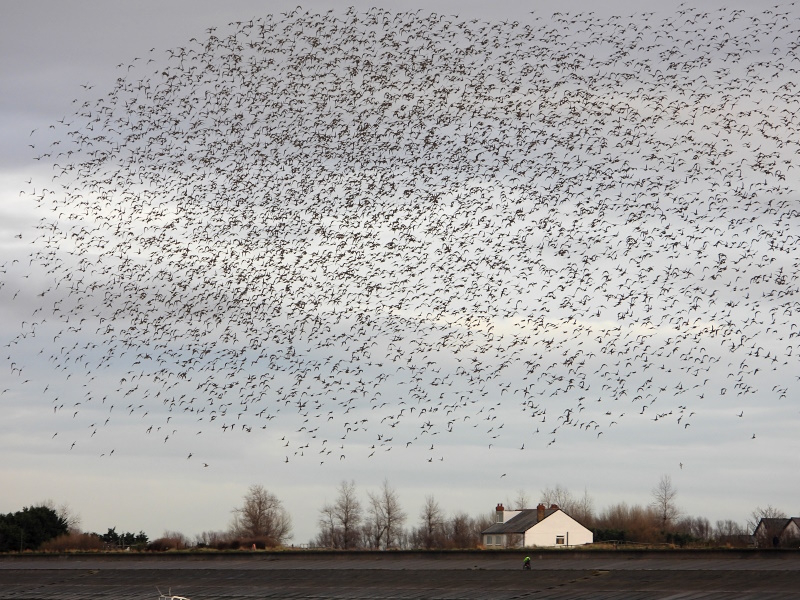
In winter Red Knot have a grey plumage but as the adults head into late
March/early April their breast feathers start to moult into a lovely
orange-red breeding plumage, hence the name Red Knot. However, Knot
born in the previous year (at this time called 2CYs as they are in
their 2nd calendar year) retain their grey plumage. Before the adults
turn red, 2CYs can be identified by their patterned juvenile wing
coverts which wear and fade to buff due to being poor quality feathers
quickly grown in the Arctic. By May, adults and the 2CY Knot can be
easily told apart as adults have some amount of red plumage while the
2CYs are still grey.

Photo taken on the 14th June 2024 by Richard Smith.
OK so we know the grey birds we are seeing at Leasowe are 2CYs but why
are they here in June? Hardly any 2CY Knot go north to the Canadian
Arctic via Iceland to breed. This is also the case for a small
proportion of 3CYs (Knot in their 3rd calendar year) as well. These
Knot stay at a few summering sites in the UK, principally the Wash and
Liverpool Bay, and a few sites in the Dutch and German Wadden Sea.
Survival of the Knot at these sites is vital to the long-term survival
of the species, as the 2CYs are the future breeding population.
So, the Knot at Leasowe are mainly young birds, but why are they at
Leasowe? Part of the reason is that 2023 was a very good breeding year
so there are many 2CYs about in 2024. OK, but 2019 was also an
excellent breeding year for Knot and during the early summer of 2020
there werenít any on the Wirral coast. In the summer of 2020, the
Ribble estuary had over 20,000 Knot summering there. That year survey
reports for cockle and mussel beds undertaken by the North Western
Inshore Fisheries and Conservation Authority show there were large
numbers of cockles in the Ribble estuary but none at Leasowe. In 2024
there are good numbers of cockles at Leasowe as well as the Ribble.
Ok we are seeing these Knot in June because as 2CYs they did not go
north to breed and have a good supply of food, but if you visit Leasowe
at high tide you wonít see any. Why? The Knot are feeding there for
about three hours either side of low tide but come the high tide they
have been flying off to roost at Seaforth Nature Reserve in Liverpool
Docks. We know this as some of these Knot carry colour marks which can
be read in the field and we have observed the movement between feeding
around low tide at Leasowe and roosting around high tide at Seaforth.
You can learn a lot about Knot behaviour using colour marking. It is a
valuable tool to understand survival, behaviour and migratory pathways.
This year coded orange flags were put on 668 young Knot at sites in
mid-Wales (Dyfi estuary), north Wales (Bangor, Llanfairfechen), in
Liverpool Bay (Hoylake, Ainsdale) and in Scotland (near Inverness). As
of 23rd June, 201 of these orange-flagged Knot have been seen at
Leasowe and at Seaforth since mid-May. Interestingly only one is from
the 120 colour marked in Scotland. Furthermore, young Knot colour
marked on the Wash and in the Netherlands this past year have not so
far been observed this summer in Liverpool Bay. Where else have
orange-flagged 2CYs been observed? Some of them, including a greater
percentage marked in Scotland, have been observed summering in the
Dutch and German Wadden Sea along with Wash and Dutch colour marked
birds.
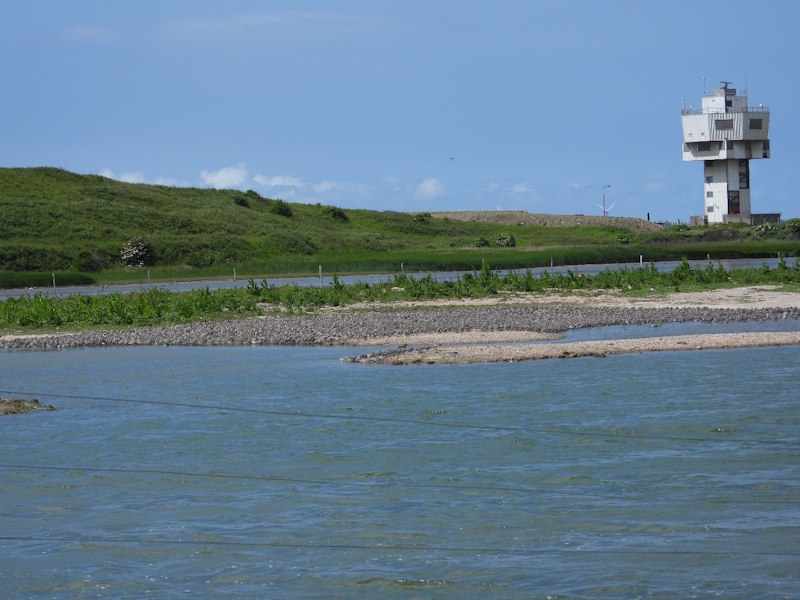
Note the wires across the lower part of the image are the electric fence that prevents fox predation of the breeding birds.
Photo by Peter Knight.
Itís nice to see these waders on the Wirral in summer. How long will
they be here? It is likely that many of the Knot will stay here for a
while. Some of them have already started to replace their worn juvenile
primary wing feathers as well as their body feathers and so in the next
few months we donít expect them to fly great distances. However, the
only other time that we have colour-marked lots of 2CY Knot, in May
2021, we found that after spending the summer on the Ribble, most left
Liverpool Bay in late autumn. So, it will be important to discover
whether this current Knot flock also disperse in the autumn. We hope
that when the adults start arriving back from the breeding grounds in
the Canadian Arctic in late July, still in their red breeding plumage,
some will join these 2CYs and there will continue to be an impressive
sight of waders at Leasowe.
Rose
Maciewicz and Peter Knight
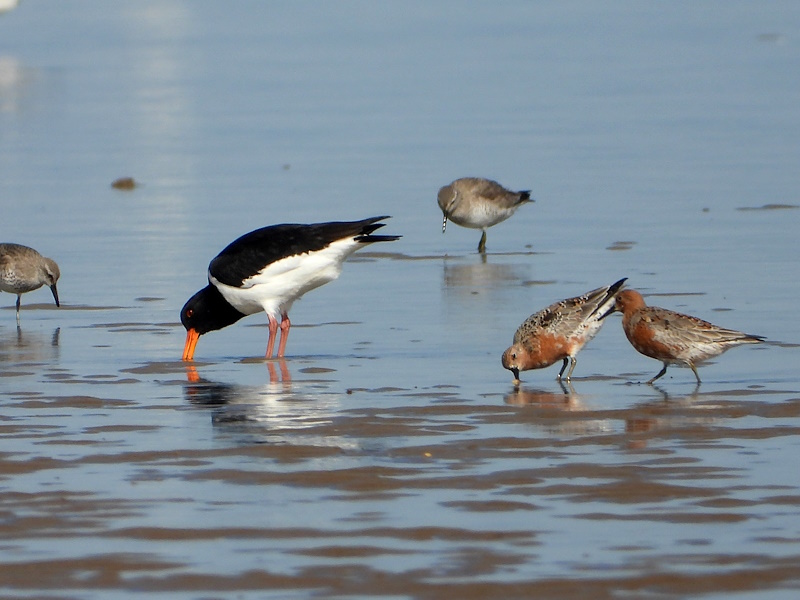
Colour Ring Report
Great White Egret
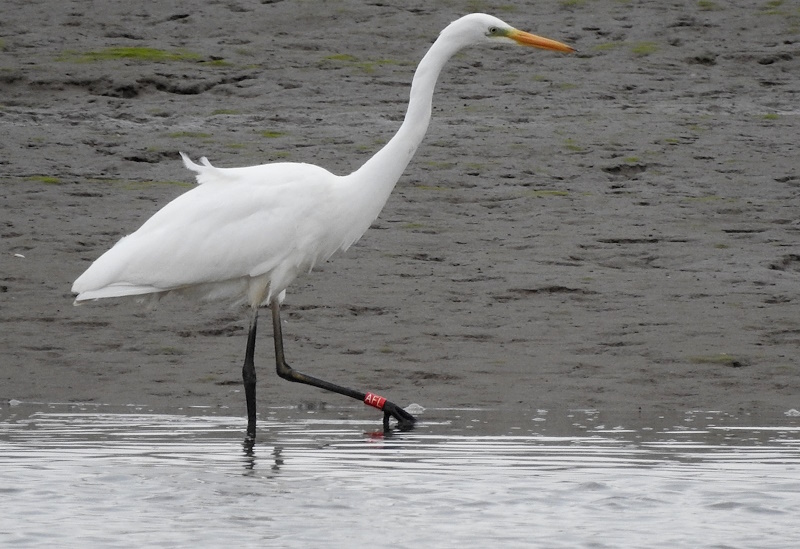
Red - AFL
Ringed at Westhay Moor Reserve (Avalon Marshes, Somerset) on April 16th
2024. Smallest chick in a brood of three.
She was still on the nest on June 10th but her two siblings had already
fledged.
Recorded at Connah's Quay Reserve on 16/06/2024 and Thurstaston Shore
on 19/06 and 20/06/2024.
This is only the second colour ringed
Great White
Egret in our database. Her sex was determined by DNA when she was
ringed. We believe that the red ring was put on the tibia (as you would
expect in order for the ring to be easily visible) but has slid down to
the tarsus at some stage.
Coot
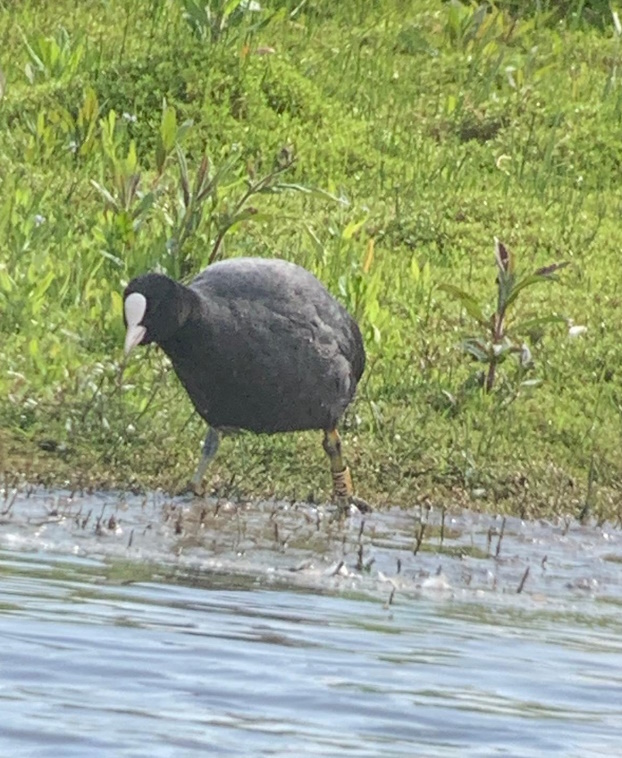
White
(RDN)
Ringed at Martin Mere on 06/12/2023.
Recorded at Burton Mere Wetlands on 06/06/2024.
This is the first colour ringed Coot
recorded in our
database. Most of us probably don't associate Coots with long
migrations but some travel hundreds of miles including beteen
continental Europe and the UK, a couple of years ago one was recorded
flying between London and St Petersburg and back!
Curlew
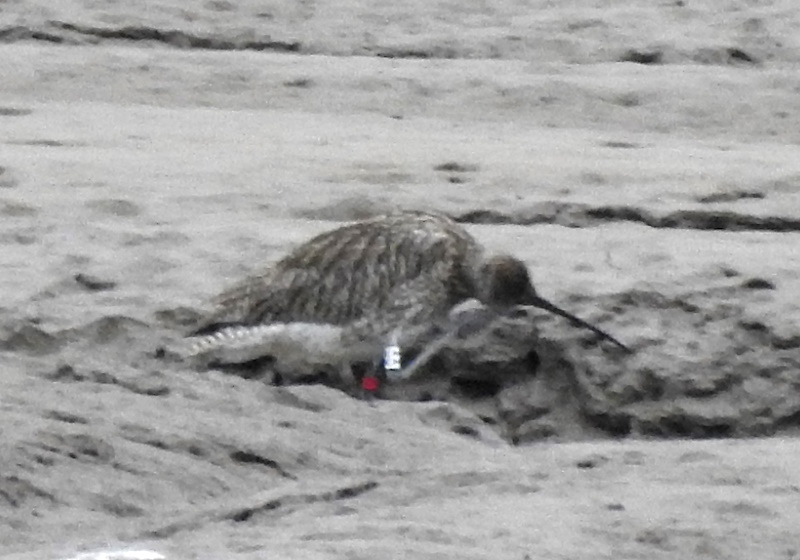
R - W(XX)
Ringed at Erde,
Schleswig-Holstein, Germany, on 22/05/2024 as a breeding male. It was
last recorded at the ringing site on 07/06/2024.
Recorded at Heswall on 18/06/2024.
Natalie Busch tells us that the area
where this
bird was ringed is a Special Protection Area and has 50 - 60 pairs of
breeding Curlews, but, like in the UK, they are struggling to maintain
numbers with low chick survival.
Black-tailed Godwit
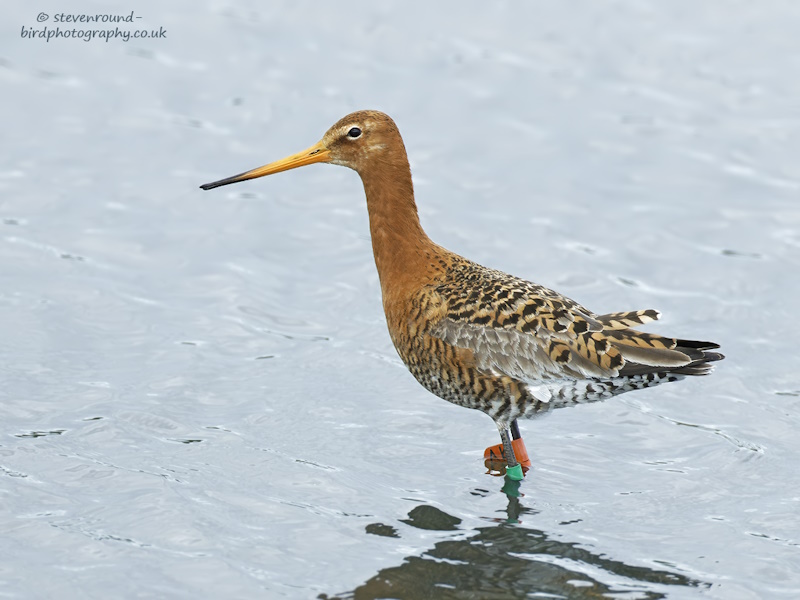
G -Oflag(AK)
Ringed at Bangor Harbour on 28/01/2024.
Recorded at Hellifield Flash, North Yorkshire, on 11/03/2024
and at Burton Mere Wetlands on 30/05/2024.
This is another of the 20 Black-tailed
Godwits which
were ringed at Bangor in January. I know at least 12 turned up in
north-west England this spring, a great return on sightings. 'AK' was
the brightest looking Blackwit at Burton at the end of May and
obviously an adult in full breeding plumage. Most are already in
Iceland by early May so it seems to be leaving it very late leaving the
UK if it is to breed this year.
Colour Rings were recorded by Richard
Smith, Stephen
Hinde, Colin Schofield,
Tony Ormond and Steve Round.
Richard Smith
June Bird News
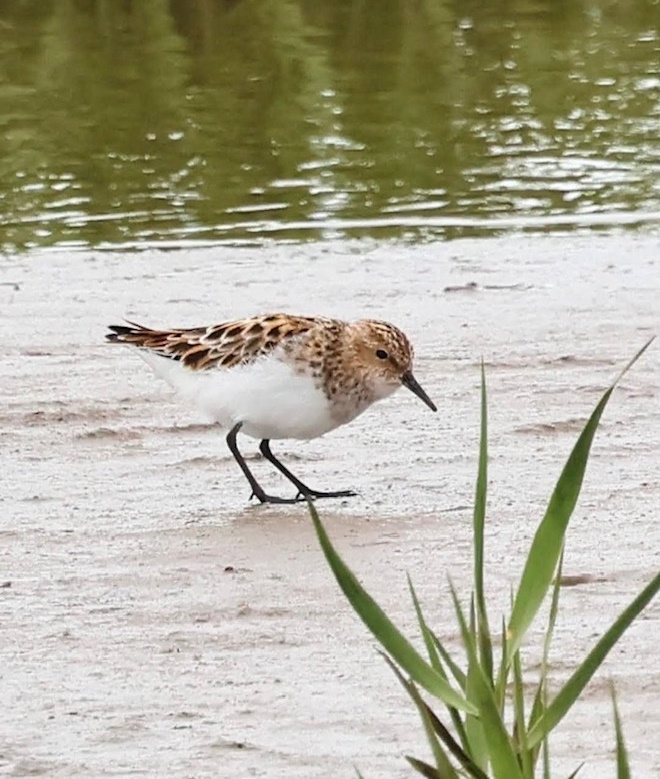
Two Little Stints on Meols Shore on the
9th had
increased to three by the 11th. Little Stints in the second week of
June are somewhat of a mega rarity and looking all the way back to 1967
in the Cheshire and Wirral Bird Reports I can find only one other
record during that week for the Dee Estuary with a single on June 12th
1988. Migrating
Little Stints are always much rarer than the return passage, most are
seen in late May but six at Inner Marsh Farm on June 1st 1997 was a
good record.
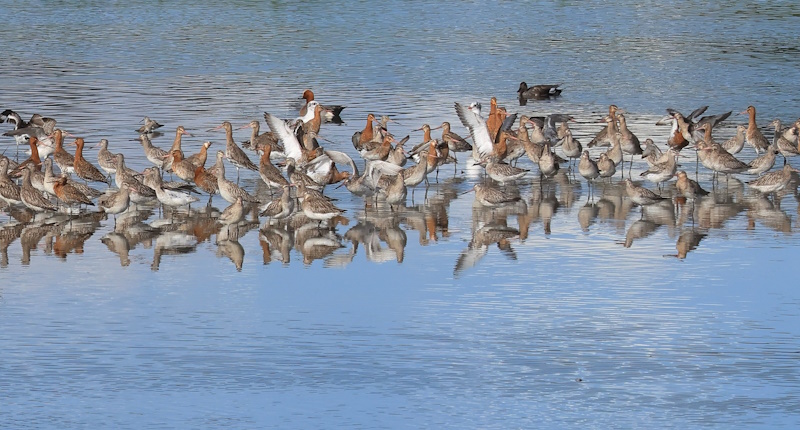
In June it is sometimes difficult to tell
whether waders are still
on spring migration, spending the summer here (either because they are
young birds or taking a year off as adults) or early returning birds.
In the above photo the Bar-tailed Godwits are all 2CY birds and
definitely not breeding, some of the Black-tailed Godwits appear to
be in breeding plumage, but most breeding Blackwits will have been in
Iceland since early May so it seems these are most likely non-breeding
3CY
birds spending the summer in this country. By June 29th the first
Black-tailed Godwits were starting to arrive back from Iceland looking
stunning in full breeding plumage.
Another species spending the summer
with us are a few
Whimbrels, and there were seven at Heswall on the 20th with five seen
two days later. However, ten Spotted Redshanks at Burton Mere Wetlands
on the 23rd will have been early returning birds, this species is one
that always has an early breeding season - they are returning after
breeding before some species, like Sanderlings, even start
laying eggs!

Left © Charles Farnell, © Ian Sheppard
You wouldn't think the two Sanderlings above are the same species! The
one on the left, is a typical summer plumaged bird photographed a few
years ago, whereas the one at Gronant, photographed this June, is a bit
of a puzzle. It's presence here in mid-June suggests it may be a
non-breeding bird, possibly 2CY. Or maybe a female which has only very
recently moulted into s/pl.

We don't see many s/pl Dunlins in the third week of June but this one
was feeding with the over-summering Knots at Leasowe. It didn't look
quite right for a typical Icelandic/NW European (schinzii) Dunlin so
I asked our
Dunlin expert, Jane Turmer, what she thought of it: "The flanks are
almost without streaking which is very unusual in schinzii but common
in centralis,
the tone of the mantle
feathers is quite chestnut, again more centralis, but the
centres of the
feathers are heavily marked and the belly patch is small, both more schinzii. So most
likely an
intergrade". Note: schinzii
mostly breed in Iceland (but inlcude UK breeders) whereas centralis breeds in
northern
central Siberia - so a big gap between the breeding ranges of these two
races. For more details see Dunlin -
Rings, Races
and Genes.
What to expect in July
As
the breeding season comes to an end birds will start piling into the
estuary - and this should include some great rarities. Last year we had
a Night Heron, Spotted Crake and Red-backed Shrike and in the recent
past rarities have included Long-billed Dowitcher, Hoopoe and Melodious
Warbler.
The species I most look forward to seeing are the Sandwich Terns filling the estuary with their raucous cries. Numbers will build through the month and should reach over 1,000 by the month-end. West Kirby on a rising tide is a good spot to see them, as is Hilbre, Gronant and Point of Ayr. With the terns will be hundreds of Black-headed Gulls, and look out for Mediterranean Gulls among them still in full breeding plumage early in the month. Numbers of these seem to increase every year - Heswall usually has the highest numbers.
Waders will arrive here in several waves over the coming weeks depending where they bred, and where they spend the winter. In July Redshanks and Black-tailed Godwits return and will reach several thousands. Common Sandpipers usually pass through in ones and twos but the banks of the River Dee, between Garden City and the Flint Bridge, seem to be particularly attractive to them, the highest total was 35 along this stretch on July 10th 2021.
Given a prolonged and strong westerly
wind Storm
Petrels are a good possibilty, New Brighton and west along north Wirral
to Hilbre are good places to see these, and there will be Manx
Shearwaters out there which will be a lot easier to spot than the
Petrels.
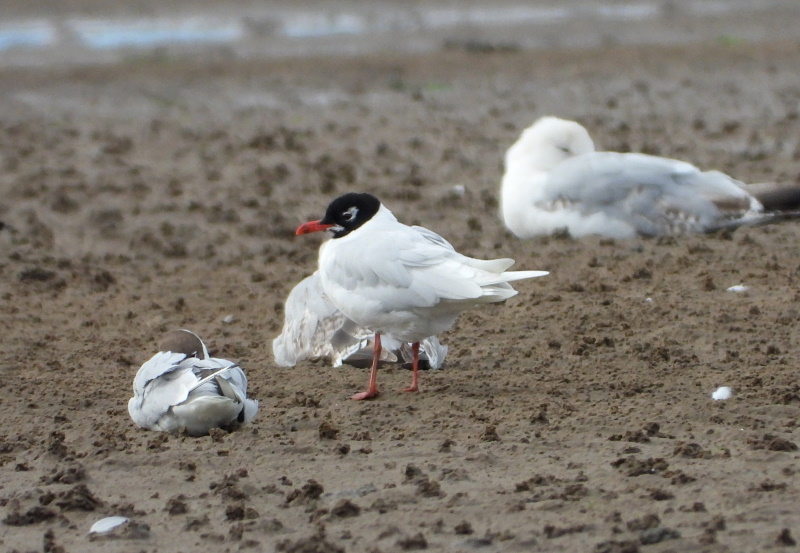
Forthcoming Events
July Highest Spring Tides (Liverpool)
Also see Tides page.
23rd July, 13.24hrs (BST), 9.3m.
24th July, 14.09hrs (BST), 9.3m.
Forthcoming Events
Also see events at https://events.rspb.org.uk/deeestuary